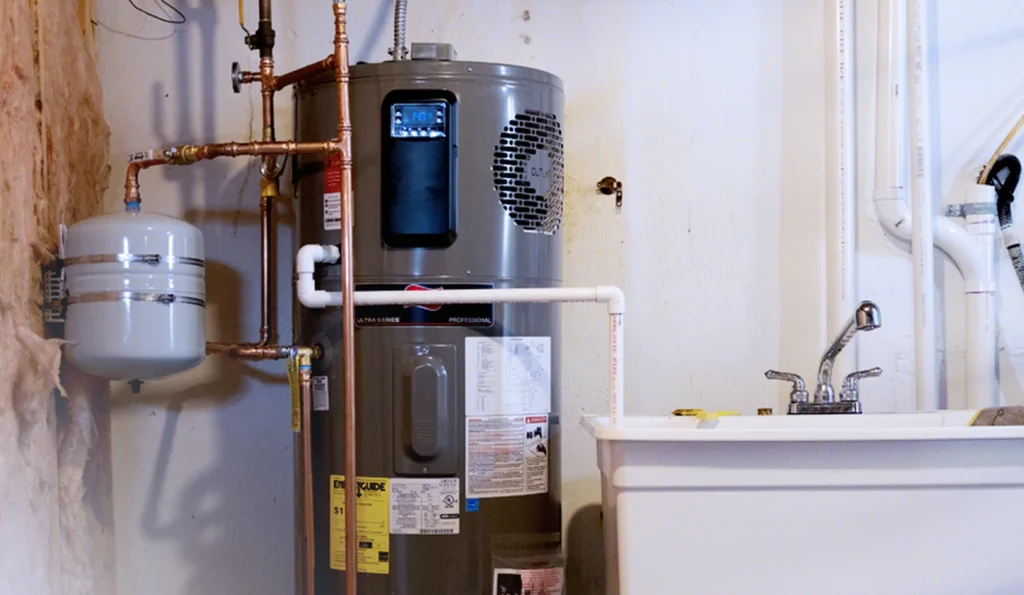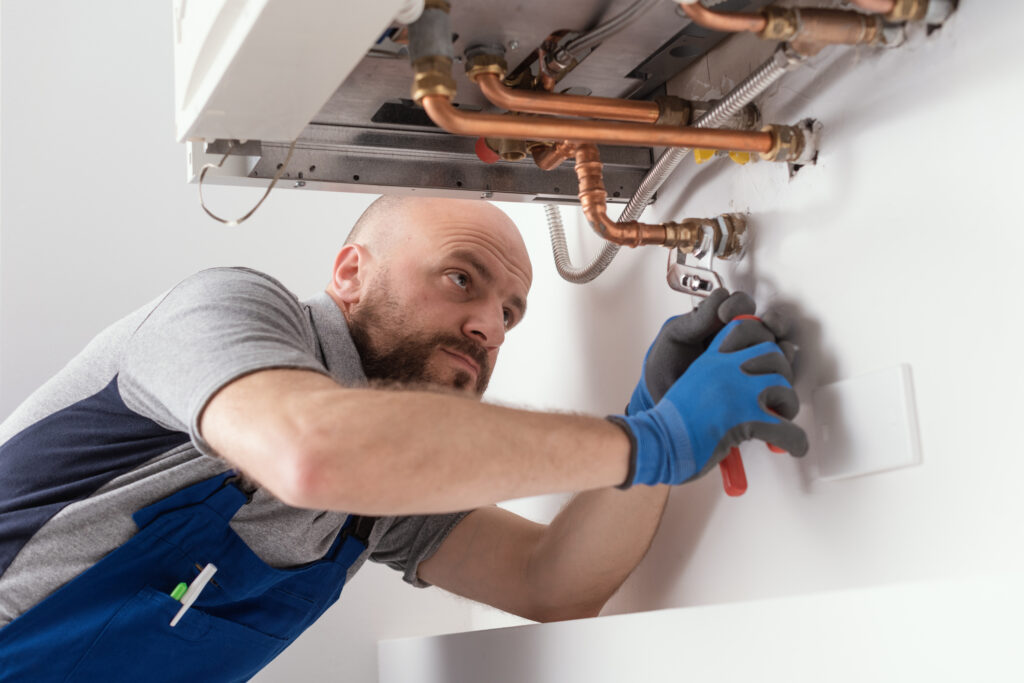A boiler isn’t just a big metal box in your home, it’s the engine that keeps your water hot and your showers comfortable. But how does it actually work?
This guide breaks down the process in plain English so you’ll know what’s happening behind the scenes, spot problems early, and make smarter choices about maintenance or upgrades.
How does a boiler work for hot water?
A boiler heats water using gas, oil, or electricity, transfers heat through a heat exchanger, and circulates it to taps, radiators, or storage tanks.
Key Takeaway
- Boilers heat and circulate hot water for taps, showers, and heating.
- Main types: combi (instant), system (with cylinder), conventional (with tank).
- Core parts: burner, heat exchanger, pump, expansion tank, controls.
- Common fuels: gas, oil, electricity, renewables.
- Modern boilers are over 90% efficient with smart controls.
- Annual servicing and pressure checks prevent breakdowns.
What Is a Boiler?

Think of a boiler as the backstage crew for your hot water. It heats water, stores it, and sends it where you need it—your shower, sink, or heating system. Instead of working like a kettle that boils water on the spot, a boiler keeps things running steady and efficient.
Most boilers run on gas, oil, or electricity, using a burner or element to heat water inside a tank or sealed system. That hot water then travels through pipes, either filling your taps directly or circulating into radiators for heat.
The best part? You don’t really need to give it much thought. A boiler just sits quietly, keeping your home warm and your water hot. If you’ve ever wondered what a boiler look like in action, think of it as a low-maintenance butler plugged in to do its job day and night.
Types of Boilers for Hot Water
Not all boilers flex the same way. The choice between a condenser boiler vs combi boiler comes down to your space, budget, and how much hot water you burn through daily.
Combi Boilers: Think of these as the minimalist’s choice. No bulky tanks, just instant hot water straight from the mains. Perfect if you’ve got a smaller place and don’t want to sacrifice closet space.
System Boilers: These come with a separate hot water cylinder but no cold-water tank. Translation: steady hot water supply for multiple showers at once. If you’ve got housemates or family fighting for bathroom time, this setup saves the drama.
Conventional Boilers: Old-school but still around. They use both a hot water cylinder and a cold-water tank. Great if you’ve got high water demand and don’t mind the extra storage space.
Bottom line? Pick the boiler that fits your lifestyle, and be ready to repair a boiler if it ever lets you down. Small flat, go combi. Busy household, system’s your friend. Big house with big needs, conventional has your back.
Key Components of a Boiler
A boiler isn’t just a big metal box in your basement. It’s a team of parts working together to keep hot water flowing, and when something goes wrong, professional boiler repair in Providence can get it back on track quickly.
The burner is where the magic starts. It’s the spark that heats everything up, whether it’s running on gas, oil, or electricity.
Next, the heat exchanger steps in. Picture it like a middleman—grabs the burner’s heat and transfers it into the water without wasting energy.
The circulator pump keeps things moving. It pushes the hot water through pipes so your taps and radiators actually feel the heat.
Then there’s the expansion tank, which saves you from pressure headaches. As water heats up and expands, the tank absorbs the extra so your system stays balanced, just like how proper boiler repair in Woonsocket keeps everything running smoothly.
Finally, the controls and thermostat act as your system’s command centre. They manage the temperature, shut things down if an issue arises, and keep everything efficient without constant oversight. And if you ever run into trouble with these components, finding expert help for boiler repair near Cranston ensures your heating stays reliable.
Step-by-Step: How a Boiler Produces Hot Water
- Fuel Kickoff: The boiler wakes up when gas, oil, or electricity gets the green light. That fuel’s the spark that starts the whole show.
- Heat Exchanger Ignition: Once the fuel burns, the heat exchanger steps in. Think of it as the DJ booth, passing the energy to the water without mixing the tracks.
- Water Circulation Begins: Cold water enters the system and glides across the heat exchanger. In seconds, it’s warming up like you are walking into a sunny patio.
- Hot Water Storage (Sometimes): In some setups, that water chills in a tank until you need it. Combi boilers skip this step, serving it fresh on demand.
- Pressure + Pumps: Pumps move the hot water through pipes like a well-oiled delivery crew. Pressure keeps it steady so your shower doesn’t flip from spa to drizzle.
- Taps + Radiators Get Served: Twist a tap or crank the thermostat, and the boiler routes that heat. Radiators stay cosy, showers stay steamy, and you don’t have to think twice.
- Smart Controls Finish the Job: Modern systems flex with thermostats and timers, so you’re not wasting energy. Hot water when you need it, chill vibes when you don’t.
Energy Sources for Boilers
- Gas: Natural gas is the most common fuel. It’s reliable, heats fast, and keeps running costs lower than most options.
- Oil: Oil-fired boilers are solid where gas lines don’t reach. They’re powerful, but expect higher fuel prices and delivery schedules.
- Electric: Electric boilers are compact and clean, no emissions in your home. Great for small spaces, but your energy bill might sting.
- Renewables: Solar thermal panels or biomass boilers let you flex your eco side. They’re pricier upfront but save money long-term while shrinking your carbon footprint.
Efficiency and Modern Boiler Technology
- Modern boilers aren’t the clunky fuel-guzzlers your grandparents had. Today’s systems hit over 90% efficiency, meaning less waste and lower bills.
- Many models use condensing tech, which recycles heat that would normally escape. It’s like squeezing the last drop out of your OJ carton.
- Smart controls add another layer. You can fine-tune heat from your phone, keeping things cosy without burning extra cash.
- Modern boilers save you money and hassle while keeping the hot water flowing, but many homeowners still ask what is the most energy efficient boiler to get the best long-term savings.
Common Problems That Affect Hot Water Supply

Boiler acting up? A few usual suspects could be the cause. Low pressure is a big one, often from leaks or bleeding radiators. Limescale buildup can also clog the heat exchanger, leaving you with lukewarm showers.
Sometimes the thermostat’s just off, giving you cold surprises. Quick fix? Check the pressure gauge, reset the thermostat, and call a pro if the problem keeps flexing. That way, you’re not stuck boiling kettles just to wash dishes.
Safety Features in Boilers
Modern boilers come stacked with safety checks. Pressure relief valves stop dangerous build-up, while automatic shut-off kicks in if something’s off.
You’ll also see flame sensors and thermostats making sure heat stays in control. Bottom line: the system’s built to keep you warm without giving you stress.
Maintenance Tips to Keep Your Boiler Running Smoothly
Give your boiler a little love and it’ll keep the hot showers flowing. Wondering how often should you service your boiler? Aim for a yearly check-up to catch small issues before they snowball into costly repairs.
Keep vents clear and bleed your radiators if they’re noisy or uneven. Check pressure levels now and then, topping up when needed. If you’re budgeting for bigger maintenance, you may also want to know what is the cost of a replacement gas boiler so you can plan.
And don’t ignore odd sounds or leaks, those are your boiler’s way of asking for help before things get messy.
Frequently Asked Questions
1. Do boilers heat water instantly?
Yep, combi boilers can. They fire up on demand so you get hot water when you turn the tap.
2. Is a boiler the same as a water heater?
Not quite. Boilers heat water for taps and also run your heating. A water heater just does hot water.
3. How often should I service my boiler?
Once a year is the sweet spot. Keeps it safe, efficient, and way less likely to break down.
Conclusion
A boiler’s job is simple: heat water and keep it flowing where you need it. Whether it’s a morning shower or a sink full of dishes, it works quietly in the background, doing the heavy lifting.
If yours is acting up, a quick service call usually fixes small issues before they snowball. Bottom line, treat it right and your boiler will keep the hot water drip steady, no drama attached.